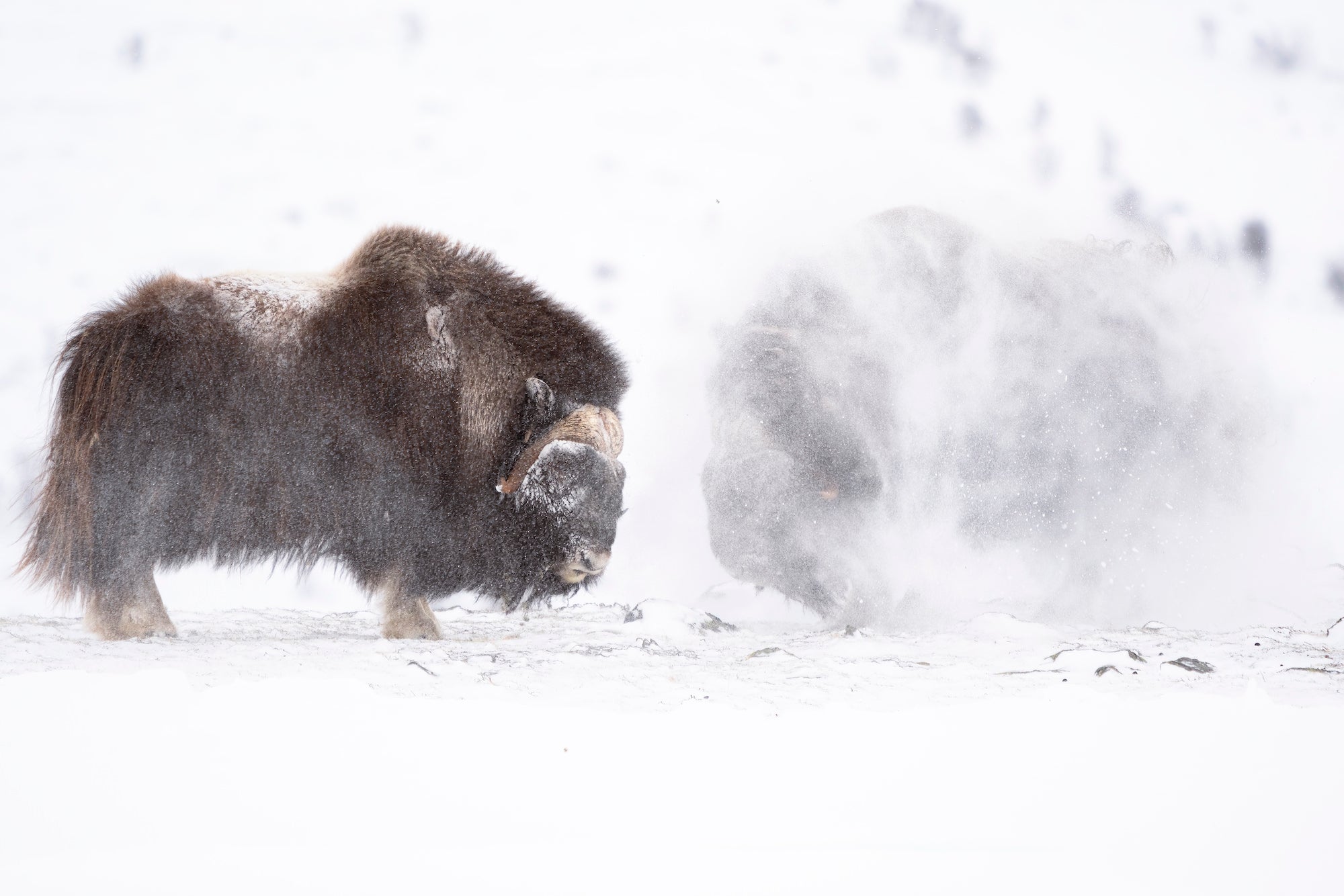Daniel Mirlea (@daniel_mirlea) is a professional nature photographer focused on nature conservation. He currently works closely and collaborates with different conservation NGOs, like WWF Romania, Rewilding Europe, and Conservation Carpathia and is also an ambassador for Nature First Photography. "Nature is our home, so I, as a nature photographer, firmly believe that one of my most significant responsibilities is raising awareness about the importance of nature and why it is mandatory to protect it. I am also trying to promote, as much as possible, a sustainable way of life in communion with nature.” We saw this image he captured of two musk oxen coming face-to-face and connected with him to learn more. Read below for more on how he captured the shot with his Sony Alpha 7R III and Sony 100-400mm f/4.5-5.6 G Master.
See how professional nature photographer Daniel Mirlea captured this image of musk oxen using his Sony Alpha 7R III and Sony 100-400mm f/4.5-5.6 G Master.

Photo by Daniel Mirlea. Sony Alpha 7R III. Sony 100-400mm f/4.5-5.6 G Master. 1/1000-sec., f/5.6, ISO 250
The Scene
Even though I work on photo projects that involve multiple subjects, scenes, etc., sometimes I like to go and explore with just an idea in mind – this time it was the Musk Ox (Ovibos moschatus), a contemporary animal with the mammoth.
I went for a week to Dovrefjell–Sunndalsfjella National Park, Norway, to seek and photograph the musk ox. I chose to go in the wintertime because I'm fascinated by how well they adapt to the harsh conditions in the arctic tundra. When I arrived there, the temperature was somewhere about -26°C (the real feeling was -33°C), and there was a lot of snow. I need to say that I rarely met these kinds of conditions in Romania, maybe just on a few hikes on the top of the mountains. So, hiking every day for 1-2 hours through the snow and that temperature was challenging but not impossible.
Even though I managed to find the musk ox on the first day, I struggled to take a good photo the entire week. That mainly happened because of the weather – the sky was blue, there were no clouds, so nothing dynamic or dramatic around.
On the last day, I was almost sure that this was it, I would get back home without any good photos, but I went for one last try in search of the musk ox in an intense blizzard. After a tiring climb, there was no sign of them in the usual place, I was so close to giving up and going back, but I thought to check if they were after a small hill in front of me. What a joy for me seeing them standing in that blizzard cause it was everything that I hoped to see, that idea from the beginning. I photographed them for around 10 minutes, and right after that, the blizzard stopped, and the blue sky reappeared. I was so lucky, and those 10 minutes were everything I came for.
The Gear
I used Sony Alpha 7R III with the Sony 100-400mm f/4.5-5.6 G Master lens for this photo. Even though this body is not focused on wildlife photography such as Alpha 9, it was a perfect choice at that moment (right now, I have an Alpha 7R IV). There are a lot of features that I use on my Sony Alpha, one of them being the APS-C, which is excellent when it's about wildlife photography to get more reach.
Another excellent feature of this kind of photography is the silent shutter – I can't imagine photographing animals without it. Also, in that kind of bad weather I had in Norway, the electronic viewfinder, in such an intense blizzard, was essential to ensure that the exposure was correct. Even more, the electronic viewfinder can help you become more creative on the spot.
On the other side, the Sony 100-400mm f/4.5-5.6 G Master is my all-time favorite lens; it's good for wildlife and landscape and suitable for close-up, as well. I believe that 80% of my photos are with this one.
How I Got The Shot
My settings for this photo were 1/1000-sec., f/5.6, auto-ISO (250), 400mm (on APSC-C mode 600mm), and exposure compensation +0.7. I used this short exposure time to freeze that snow powder and have the scene more dramatic. In wildlife photography, most of the time I use auto-ISO because everything is dynamic, and the scene can change from one second to another. In this way, I can be more focused on my subject and the composition without any risk of not getting the proper exposure.
The Edit
The post-processing of this photo is pretty minimal. This kind of scenario didn't need too much attention, and I wanted to keep it as natural as possible (like in the moment I saw it). So I tweaked it a little bit in Adobe Lightroom and Photoshop.
See more of Daniel Mirlea’s work on Instagram @daniel_mirlea.



